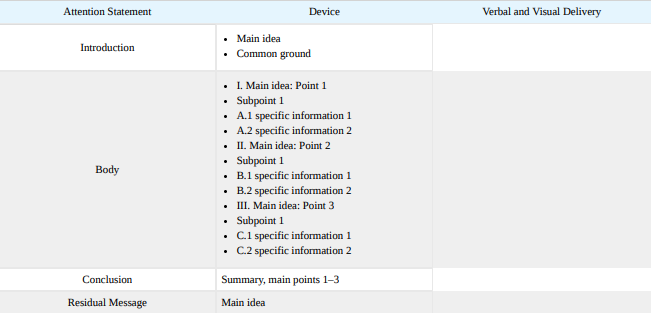Learning Objectives
Understand how to create two different styles of outlines for a speech.
Chances are you have learned the basic principles of outlining in English writing courses: an outline is a framework that organizes main ideas and subordinate ideas in a hierarchical series of Roman numerals and alphabetical letters. The center column of Table 12.4.1 presents a generic outline in a classical style. In the left column, a speech’s five main structural elements are tied to the outline. Your task is to fill in the column outline with the ideas and points you make in your speech. Feel free to adapt it and tailor it to your needs, depending on the specifics of your speech. Next, fill in the right column with your speech’s verbal and visual delivery features.

However, no law says a speech outline has to follow a classical outline format. Table 12.4.2 is an alternate outline form you may want to use to develop your speech. As you can see, this outline is similar to the one above in that it begins with the five basic structural elements of a speech. In this case, those elements are tied to the speech’s device, thesis, main points, summary, and recap of the thesis. In the right column, this outline allows you to fill in the cognate strategies you will use to get your points across to your audience. You may use this format as a model and modify it as needed.

Key Takeaway
An outline is a framework that helps the speaker organize ideas and tie them to the main structural elements of the speech.
Exercises
The next time you attend a class lecture, try to take notes in outline form, using the sample outlines in this chapter as a guide.
You may want to do this as a class project: have all your classmates put their notes into outline form and then compare the
student outlines with the outline the professor began with when planning the lecture.
Create an outline of your day, with main headings and detail points for your main tasks of the day. At the end of the day, review
the outline and write a brief summary of your experience. Share with classmates.
Diagram or create an outline from a sample speech. Do you notice any patterns? Share and compare your results with
classmates.
This page titled 12.4: Sample Speech Outlines is shared under a CC BY-NC-SA 3.0 license and was authored, remixed, and/or curated by Anonymous (LibreTexts Staff), from which source content was edited to the style and standards of the Pressbook platform licensed under a Creative Commons Attribution-NonCommercial-ShareAlike 4.0 International License by Brandi Schur.

